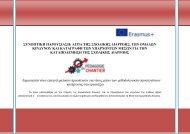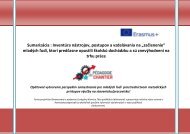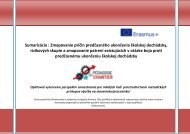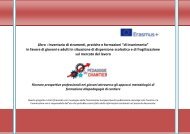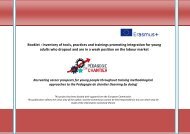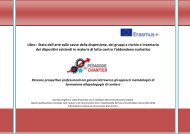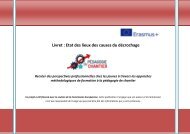Livret Inventaire EN
Inventory of tools, practices and trainings promoting integration for young adults who dropout and are in a weak position on the labour market
Inventory of tools, practices and trainings promoting integration for young adults who dropout and are in a weak position on the labour market
Create successful ePaper yourself
Turn your PDF publications into a flip-book with our unique Google optimized e-Paper software.
Booklet : Inventory of tools, practices and trainings promoting integration for young<br />
adults who dropout and are in a weak position on the labour market<br />
Recreating career prospects for young people throughout training methodological<br />
approaches to the Pedagogie de chantier (learning by doing)<br />
This project has been funded with support from the European Commission.<br />
This publication reflects the views only of the author, and the Commission cannot be held responsible for any use which may be<br />
made of the information contained therein
Preamble<br />
This booklet is an overview of 2nd intellectual output of our project : Inventory of tools, practices and<br />
trainings promoting integration for young adults who dropout and are in a weak position on the labour<br />
market<br />
For detailed information you can acces the overall report on our website http://pedachantier.eu,<br />
2
I. Inventory of tools, practices and trainings promoting integration for<br />
young adults who dropout and are in a weak position on the labour<br />
market<br />
This annex introduces the synthesis (an abbreviated version) of the intellectual production O2 of the<br />
project Educational Working approach “Inventory of the tools, practices and inclusion training” in<br />
favour of young adults in situation of school dropout and weakening on the job market” realized in the<br />
framework of the EU project “Pedagogie de chantier (learning by doing)” financed by the Erasmus +<br />
program. The whole report is available from every project partner.<br />
3
After a preliminary situational analysis of school dropout causes, groups at risk and to a census of<br />
existing system fighting against school dropout in every partner’s area (above deliverable 01), the<br />
project partners compiled an inventory of “inserting” practices in favor of young adults in a position of<br />
school dropout. These results will be used as a basis for the training model “To train professionals to<br />
the Pedagogie de chantier (learning by doing)” (O3) and allow to draw the environmental conditions to<br />
favour the experimentation:<br />
• Different roles, actions and targets of structures;<br />
• Characteristics of target groups<br />
• Potential obstacles to the setting of a developed system<br />
• Socio-economical context<br />
4
This O2 report begins with a synthetic reminder of national educational, training and inserting<br />
framework and professional insertion of young adults in position of school dropout. It shows a general<br />
table of approaches followed by partner countries of the project Pedagogie de chantier (learning by<br />
doing). In most countries, it seems necessary to improve the watch, the gathering and the analysis of<br />
data to develop targeted and efficient politic. The conclusion of this part confirms the previous<br />
observation (deliverable O1), as rephrased bellow:<br />
The strengthening of a public policy fighting against school dropout is necessary to all institutional<br />
actors covered by the Pedagogie de chantier (learning by doing) project. This policy should associate<br />
every institutional but also associate field actors (in a global way the civil society) which happen today<br />
to find solutions for young people having learning troubles.<br />
Likewise, prevention of early school leaving must become a priority, while enhancing the positive<br />
efforts aimed to look after young people, once their difficulties are detected.<br />
5
Collaborative method<br />
Confronting the diversity of approaches and systems of “curative measure” or “intervention against<br />
school dropout”, partners tried to identify the best tools, practices and existing training. In order to<br />
achieve this, an empirical method of data collection about practices of training and collecting tools<br />
have been prepared. Two target groups have been previously defined in order to collect the necessary<br />
information: trainers, structures and organizations to implement systems in favour of young adults in<br />
situation of school dropout, vulnerability on the job market, economic and social exclusion in one hand<br />
and public and local authorities in charge of inserting policies in another hand. Questionnaires have<br />
been sent to them in order to have their opinions heard.<br />
This work highlighted the diversity of systems, policies, practices and tools preventing school dropout<br />
and professional insertion of young people in situation of school dropout and weakened on the job<br />
market at the scale of the 5 partner countries (Belgium, France, Italy, Slovakia) and in the following<br />
fields:<br />
6
• Type and characteristics of involved organizations in the fields of preventing school dropout<br />
and inserting young people.<br />
• Kind of policies preventing school dropout<br />
• Policies to limit negative impacts of school dropout.<br />
• Approach method of young people<br />
• Inserting actions on the job market<br />
• Creation of an entrepreneurial activity, self-employment<br />
• Type of support/promotion to insert young people on the job market<br />
• Source of funding of initiatives, insertion on the job market (job) and professional insertion<br />
(creation of company, self-employment)<br />
• Initiative efficiency according to the actors in the fight against school dropout and for the<br />
insertion of young people.<br />
These fields have been identified by the project partners as essential elements of understanding and<br />
analysis of inserting policies implemented in partner territories. They are also reflections which enable<br />
exchanging and sharing information and practices between the different levels of concerned actors and<br />
7
European countries. The aim is to describe some precise initiatives observed. Professional insertion of<br />
young people being in a situation of school dropout and weakened on the job market has been<br />
emphasized, unlike the upstream prevention of school dropout. These measures and practices may be<br />
efficient or not, may bring enough convincing results; but saying a few words about these measures<br />
and practices enables reflection about choices to make or not to efficiently prevent school dropout and<br />
encourage inclusion of youngsters with difficulties, to be taken further.<br />
Results<br />
Practices and tools identified enabled project partner to develop (or confirm) ideas to improve<br />
professional insertion of young people dropping out of school:<br />
1. Prevention from school dropout involves the whole initial training system and its partners,<br />
going from actions of prevention to caring for youngsters who left system without any diploma.<br />
The scope of the policy should necessary cover the three fields (prevention, intervention, and<br />
remediation) and integrate all the preventing actions upstream school dropout, caring for<br />
8
students with difficulties training, and caring of young people without any diploma from any<br />
training system. This requires bringing the different stakeholders of public policy together<br />
(ministries, associations, etc…).<br />
2. Compensation measures: Compensation measures targets young people who already left<br />
school. They are much diversified according to the particular country concerned. We can<br />
roughly classify main initiatives by the following way:<br />
• Management of a “second-chance learning”<br />
• Recognition of prior learning and accreditation device which strengthen self-confidence<br />
and foster the reintegration;<br />
• Individual targeted help (social, financial, educative, psychologic), especially for the young<br />
leaving with major problems.<br />
3. A new opportunity to get qualified<br />
4. A bigger training modularity and paths flexibility should be suggested and experimented: The<br />
French Ministry of Education, the public employment service, the Regions and the different<br />
9
stakeholders should also be able to bring concrete answers to the young who left the initial<br />
training system. Allowing more flexibility in the training and the awareness of knowledge at<br />
various stage of the youth’s path as well as an individual support could represent suitable<br />
solutions for the youngster having learning troubles.<br />
5. Creating the necessary leverage to the achievement of the prevention policy of school dropout<br />
and professional insertion of young. In order to create prerequisites to a successful inserting<br />
policy of young dropping out and facing difficulties on the labour market, leverages should be<br />
activated: financial reinforced means, more performing tools, a partnership governance, a<br />
change management and an adapted human resources policy and finally, a more systematic<br />
assessment of schemes and experimentations. <br />
10





